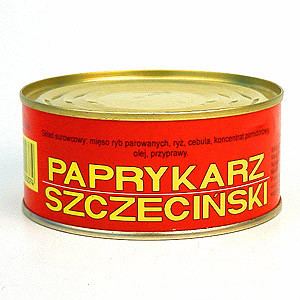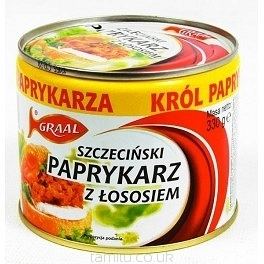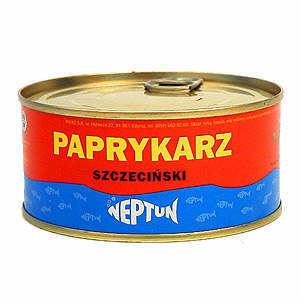Invented 1965–1967 | ||
 | ||
Main ingredients Rice, Tomato paste, Vegetable oil Similar Rice, Tomato paste, Pasztecik szczeciński, Vegetable oil, Salceson | ||
Smaki prlu paprykarz szczeci ski
Paprykarz szczeciński ([paˈprɨkaʂ ʂt͡ʂɛˈt͡ɕiɲskʲi]) is a Polish canned fish spread made from ground fish, rice, tomato paste and vegetable oil, seasoned with onion, salt and spices. It has the form of a reddish-brown paste with visible rice grains. The recipe, inspired by a West African dish sampled by Polish fishermen, was developed in the 1960s at PPDiUR Gryf, a state-owned far-sea fishing and fish processing company based in the Polish port city of Szczecin. Since the company's bankruptcy in the early 1990s, paprykarz szczeciński has been produced by other fish processing plants in various locations throughout Poland. A popular snack, especially with students and hikers, it remains a symbol of Szczecin's local identity.
Contents
- Smaki prlu paprykarz szczeci ski
- Jak si robi idealny paprykarz szczeci ski
- Etymology
- Description
- History
- In culture
- References
Jak si robi idealny paprykarz szczeci ski
Etymology

The term paprykarz szczeciński is Polish. The word paprykarz refers to a spicy stew seasoned with paprika, or powdered chili pepper. It derives from Hungarian paprikás, which denotes a dish of meat (beef, veal, pork or chicken) stewed with onions, paprika and sour cream, known outside of Hungary as a variant of goulash. The adjective szczeciński denotes anything coming from or related to Szczecin, a port city in West Pomerania, northwestern Poland.
Description

The ingredients of paprykarz szczeciński differ by producer, but they typically include ground fish of various kinds, tomato paste, rice, onion, vegetable oil and spices. A Polish standard introduced in 1967 specifies "Nigerian pepper" as the principal spice. The spread is a uniform paste of light to dark red or reddish-brown color, with visible grains of rice. The consistency is firm, ranging from slightly dry to juicy with a possible thin layer of oil on the surface. The product is sterilized and packed into steel or aluminum cans.
History

The original recipe for paprykarz szczeciński is attributed to Wojciech Jakacki (1924–1987), deputy director and production manager at PPDiUR Gryf ("Griffin"), a state-owned far-sea fishing and fish processing company based in Szczecin. Its invention was a result of an efficiency improvement project whose goal was to find a way to use up fish scraps left over from cutting blocks of frozen fish on Gryf's fishing trawlers. The recipe was developed in Gryf laboratories between 1965 and 1967. The company's far-sea fishing activity at that time was located off the coast of West Africa. According to Bogusław Borysowicz, a co-founder and long-time employee of Gryf, the recipe was inspired by "chop-chop", a West African delicacy sampled by Gryf's fishermen in one of the local ports. The dish contained fish, rice and a hot spice called "pima". In 1967, Jakacki and his colleagues were issued a certificate for rationalization proposal, which, under communist intellectual property law, awarded them limited property rights to their improvement idea and allowed to put it in place. The first cans of paprykarz szczeciński were manufactured in the same year.
Originally, paprykarz szczeciński contained scraps of various kinds of fish caught off the West African coast, such as red porgy, as well as tomato pulp imported from the southern countries of the Eastern Bloc – Bulgaria, Hungary and Romania – and a spice imported from Nigeria. The fish component changed with time, as Gryf moved its fishing fleet to new locations; at various points, the paste contained Alaska pollock and blue grenadier from the Pacific Ocean or southern blue whiting from the waters around the Falkland Islands. By the end of the 1960s, the company had left the West African waters due to the Nigerian Civil War; in 1977, it moved out of the northern Pacific Ocean when Canada and the United States claimed their exclusive economic zones; and in 1982, it had to abandon the Falkland waters because of the Argentine-British war.

Due to its low price and long shelf life, the spread quickly gained popularity among Polish students, artists and hikers. At the turn of the 1980s, paprykarz szczeciński amounted to about 50 percent of Gryf's total annual canned fish output of 22,000 tonnes (24,000 short tons). The product became Poland's export hit that was sold to 32 countries, including Côte d'Ivoire, Denmark, Hungary, Japan, Jordan, Liberia, the Soviet Union, Togo and the United States. According to Gryf's internal report, the recipe was copied in Colombia, which exported its own version of the fish spread to neighboring countries.
An economic downturn, which hit Poland in the 1980s, resulted in inferior quality of the product. The Nigerian spice was replaced with cheaper Hungarian paprika and the original fish content of 50 percent was reduced in favor of rice. It was common to find fragments of fins, scales and bones in the paste. A slump in the sales of paprykarz szczeciński in the mid-1980s was brought about by a public revelation that the meat of the southern blue whiting was heavily infested with Kudoa alliaria, a myxozoan parasite infecting marine fish. Consumers feared that the infected fish, rather than being recalled from the market, was ground and mixed into the paprykarz; some people took grains of rice visible in the paste for parasite cysts. During the food shortages of the time, cans of the fish paste often remained on grocery shelves along with vinegar as the only food products available.
With Poland's transition from command to market economy in the early 1990s, Polish far-sea fishing business became economically unsustainable, bringing Gryf to bankruptcy. According to Borysowicz, paprykarz szczeciński was protected by a patent, but the documents were lost during the company's liquidation. Several other Polish companies tried, without success, to obtain a patent for the same product in the 1990s and 2000s. As a result, both the recipe and the name of paprykarz szczeciński are legally unprotected, allowing various producers throughout Poland (all outside Szczecin) to manufacture their own versions of the paste, often using freshwater fish, under the same name. In 2010, the Polish Ministry of Agriculture and Rural Development placed paprykarz szczeciński on an official list of traditional products, per request from the West Pomeranian regional authorities. While this recognition itself does not grant the recipe any legal protection, it is considered a first step for Szczecin towards having the paste's name and geographic indication protected under European Union law.
In culture
Paprykarz szczeciński was one of the most recognizable brands in communist Poland. Due to its popularity and association with the main city of West Pomerania, it has become a part of Szczecin's post-war local identity even though it is no longer produced in this city. The paprykarz shares this status with another local food product, a meat-filled pastry known as pasztecik szczeciński. The word Paprykarz is sometimes humorously used by people from other parts of Poland to refer to inhabitants of Szczecin and particularly to the players and fans of Pogoń Szczecin, the local soccer club.
